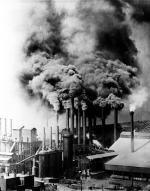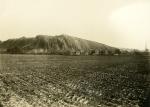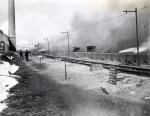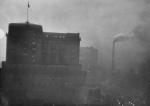Chapter Two: Exploitation and Renewal
In 1866, the Civil War was over and James Andrews was fed up. Smoke and acidic fumes from the neighboring brick factory had been ruining his grapevines, orchards and trees for years. So Andrews filed a nuisance suit and won. But the brick company appealed its conviction all the way up to the Pennsylvania Supreme Court, which in 1872 overturned the judgment against the brick kiln owner.
Using arguments based upon "balancing doctrine," the Supreme Court ruled that Andrews's suffering had little legal merit, for it was the type of discomfort to which people "voluntarily subject themselves" for the great benefit they think they derive" from living and doing business in and near modern cities. The Court was reluctant, it explained, to bring "crushing force upon the every-day business of men," or to destroy "the value of his property for legitimate uses."
for legitimate uses."
The Court's ruling in "Huchenstine's Appeal" would have a lasting impact. Arguing that the economic costs of conviction would impair an entrepreneur's ability to conduct business, Pennsylvania courts pushed pollution problems into the category of "trivial harm" and for decades were reluctant to punish polluters.
In case after case, they dismissed the sufferings of families poisoned by a lead-pipe factory or deprived of water by acid runoff from coal mines as "a mere personal inconvenience," and ruled that the illnesses suffered by residents of towns whose air and water were contaminated were less important than the rights of industries to dump their wastes without restriction.
At the time, the Court's decisions reflected the widespread belief among American businessmen and politicians that an unregulated economy brought the greatest good to the greatest numbers. It was a belief that seemed to be supported by the state's and nation's booming economies. Industrialization was transforming America into an economic superpower.
On the eve of the Civil War, more than 70 percent of Americans lived on farms or in small farm towns, and agriculture was the nation's largest and fastest-growing business. Just forty years later the United States was the world's most productive industrial nation, and more than 40 percent of Americans lived in towns or cities. American industries needed workers. Between 1865 and 1900, the nation's population more than doubled in size, from 36 to 76 million, as immigrants and people from the countryside poured into Pittsburgh, Philadelphia, New York, Chicago and the nation's other fast-growing industrial cities in search of jobs.
The Industrial Revolution was fueled by coal, iron and other raw materials that lay in great abundance in Penn's woods. Anthracite, or hard coal, from northeastern Pennsylvania fueled the shops and mills of Philadelphia, the nation's first great manufacturing center, and the locomotives of the great Pennsylvania Railroad, the largest corporation in the world. The great bituminous, or soft coal, deposits of western Pennsylvania fueled the furnaces of Pittsburgh's steel mills and factories.
Mining, drilling, iron and steel, and railroads were all heavily polluting industries. Production took place in factories, mills, and refineries that generated enormous volumes of smoke and fumes, and that used water to carry away their wastes. Iron plantations had been filling Pennsylvania's skies with smoke for generations. Since the time of William Penn, the furnaces that smelted iron ore into pig iron had been fueled by charcoal made from wood. To convert wood to charcoal, great bundles of cord wood had to be stacked in a cone, covered with damp leaves and turf, and then burned from three to ten days. These cones gave off huge clouds of dark, smelly smoke that blanketed the surrounding valleys with the smoke pouring out of the chimneys of the iron furnaces.
There was nothing new about smoke pollution. The blackened lungs of corpses from our ancient ancestors show that it dates back to Paleolithic times, when our cave dwelling ancestors burned fires to illuminate the night and ward off mosquitoes. For centuries Pennsylvanians cooked their food and warmed their houses with wood. By the early 1800s, the air in Pennsylvania's growing cities could be foul, as the smell of feces, urine and rotting garbage dumped on the streets mingled with the wood smoke from a thousand chimneys.
But the air pollution menace of the industrial world was much greater and more concentrated. By the end of the Civil War, Allegheny County produced half the glass and more than 40 percent of the iron manufactured in the United States. The smelting of iron and rail transportation of raw materials and finished products were both dependent upon coal.
By 1884 Pittsburgh was burning three million tons a year. "Pittsburg," wrote Willard Glazier, "is a smoky, dismal city at her best. At her worst, nothing darker, dingier or more dispiriting can be imagined¦ the smoke from her dwellings, stores, factories, foundries and steamboats, uniting, settles in a cloud over the narrow valley in which she is built, until the very sun looks coppery through the sooty haze."
through the sooty haze."
The Pittsburgh steel mills were fueled not by charcoal, but by coke, a fuel made by burning off the impurities of the bituminous coal found in huge deposits nearby. By 1911, bituminous coal and coke fueled 98 percent of the pig iron manufactured in the United States. More than half the nation's coke ovens were located in Connellsville, not twenty miles southeast of Pittsburgh.
Day and night the coke ovens burned, spewing out steam, sulfur, hydrocarbon gases and ash that rained down upon the surrounding countryside, creating what a state botanist in 1900 called "a general wretchedness of everything of the nature of a shrub or tree." Workers dumped the solid wastes from the coke ovens into nearby creeks, killing fish, insects and other organisms, and clogging their channels, which led to floods that silted bottomlands with contaminated wastes.
coke ovens burned, spewing out steam, sulfur, hydrocarbon gases and ash that rained down upon the surrounding countryside, creating what a state botanist in 1900 called "a general wretchedness of everything of the nature of a shrub or tree." Workers dumped the solid wastes from the coke ovens into nearby creeks, killing fish, insects and other organisms, and clogging their channels, which led to floods that silted bottomlands with contaminated wastes.
Occasionally local residents fought back, filing lawsuits for damages to their property and their health, but in Pennsylvania, legal doctrine favored business and economic growth over public health. "Smoke," wrote Chicago businessman W. P. Rend in 1892, "is the incense burning on the altars of industry. It is beautiful to me. It shows that men are changing the merely potential forces of nature into articles of comfort for humanity"– and growing rich in the process.
Pennsylvanians, like other Americans, tolerated the pollution of their water, air and soils because of the benefits brought to them by industry. But the human costs of polluted water and air became so great that an outraged public forced the courts and the state government to respond.
In the 1890s, environmental reform groups led by people like Harrisburg's J. Horace McFarland and
J. Horace McFarland and  Mira Lloyd Dock pushed for nuisance laws and new pollution ordinances to clean up their cities and towns. In 1916 a state court ruled that U.S. Steel could no longer dump wastes from its coke ovens in McKeesport into the Monongahela River because of the impact on public health. In 1923 the Pennsylvania legislature created a State Sanitary Water Board to control pollution in the Commonwealth's streams, and forged cooperative agreements with oil, tanning and paper industries to voluntarily curb their dumping.
Mira Lloyd Dock pushed for nuisance laws and new pollution ordinances to clean up their cities and towns. In 1916 a state court ruled that U.S. Steel could no longer dump wastes from its coke ovens in McKeesport into the Monongahela River because of the impact on public health. In 1923 the Pennsylvania legislature created a State Sanitary Water Board to control pollution in the Commonwealth's streams, and forged cooperative agreements with oil, tanning and paper industries to voluntarily curb their dumping.
Flood control was another issue that pitted business interests against public safety. Never was the human cost of unregulated dam construction and maintenance more dramatically demonstrated than during the great Johnstown Flood of 1889, which killed 2,209 people. A horrified American public responded with donations of money and supplies, and doctors, nurses,
Johnstown Flood of 1889, which killed 2,209 people. A horrified American public responded with donations of money and supplies, and doctors, nurses,  Clara Barton and the American Red Cross arrived to provide medical assistance and emergency shelter and supplies.
Clara Barton and the American Red Cross arrived to provide medical assistance and emergency shelter and supplies.
Despite arguments that the selfishness and apathy of a handful of wealthy landowners had caused the most deadly "natural" disaster in American history, the Commonwealth did not pass dam inspection legislation until after collapse of the Bayliss Dam flooded Austin and killed seventy-eight people in 1911.
Austin and killed seventy-eight people in 1911.
In the 1930s and 1940s national debates on the role that the federal government should play in water quality and flood control issues often focused on Pennsylvania problems. Water pollution was a threat to public health and fisheries, but Pennsylvania exempted coal mines from water pollution regulations. So coal companies dumped their wastes into the state's streams, including two to three million tons of sulfuric acid into the Ohio River near Pittsburgh every year.
The Great Depression provided the federal government the opportunity - and funding -to become actively involved in flood control and the fight against water pollution. Secretary of the Interior Harold Ickes used New Deal work relief programs to seal abandoned coal mines, and to construct two million sanitary privies, and 2,500 sewage systems and treatment plants. In Bucks County, the federal government assisted in the creation of the
Harold Ickes used New Deal work relief programs to seal abandoned coal mines, and to construct two million sanitary privies, and 2,500 sewage systems and treatment plants. In Bucks County, the federal government assisted in the creation of the  Honey Hollow Watershed, a prototype for thousands of watersheds designed to protect soil, water and wildlife across the nation. After the City of Johnstown flooded yet again in 1936, the Army Corps of Engineers constructed The
Honey Hollow Watershed, a prototype for thousands of watersheds designed to protect soil, water and wildlife across the nation. After the City of Johnstown flooded yet again in 1936, the Army Corps of Engineers constructed The  Johnstown Flood Control Project, the largest flood-control system in the country. Despite these initiatives, it was not until the end of the Second World War that the American public demanded improvement of the foul water and air their industrial economy had created.
Johnstown Flood Control Project, the largest flood-control system in the country. Despite these initiatives, it was not until the end of the Second World War that the American public demanded improvement of the foul water and air their industrial economy had created.
After the war, the Commonwealth finally passed laws that required mining companies to backfill and replant areas they had stripped for coal. A killer smog that smothered the western Pennsylvania town of Donora in 1948 drew national attention to the need for federal air protection legislation. At the same time, Pittsburgh Mayor
Donora in 1948 drew national attention to the need for federal air protection legislation. At the same time, Pittsburgh Mayor  David Lawrence and local business leaders were revitalizing the city by attacking smoke pollution, controlling floods and creating more livable urban spaces.
David Lawrence and local business leaders were revitalizing the city by attacking smoke pollution, controlling floods and creating more livable urban spaces.
Even as the state and nation were addressing the old pollution menaces, American corporations were introducing new technologies and chemical compounds that promised to further improve American life. With DDT and other new pesticides we would win our age-old battle against agricultural pests. Nuclear energy would provide a safe, inexhaustible source of energy that would pollute neither our water nor our air. For generations Americans had devoted their energies to taming the wild forces of nature: to killing predators, harnessing the flow of rivers and paving highways into the wilderness. In the twentieth century, more and more Americans were becoming alarmed by the disappearance of wilderness areas.
Pennsylvanians played major roles in all phases of the modern environmental movement. Western Pennsylvania gave the nation four of the most influential environmentalists of the twentieth century. Howard Zahniser wrote the Wilderness Preservation Law of 1964. Johnstown congressman Howard Saylor steered the Wild and Scenic Rivers Act of 1968 through Congress, which protected unspoiled stretches of the Colorado, the Delaware and the
Howard Zahniser wrote the Wilderness Preservation Law of 1964. Johnstown congressman Howard Saylor steered the Wild and Scenic Rivers Act of 1968 through Congress, which protected unspoiled stretches of the Colorado, the Delaware and the  Allegheny rivers from damming and pollution. Writer
Allegheny rivers from damming and pollution. Writer  Edward Abbey became one of the nation's most eloquent voices in defense of wilderness. No single person, however, was more important to the birth of the modern environmental movement than
Edward Abbey became one of the nation's most eloquent voices in defense of wilderness. No single person, however, was more important to the birth of the modern environmental movement than  Rachel Carson, whose book Silent Spring first exposed the deadly impact of DDT and other chemical pesticides on birds and other wildlife. And no single event drove home the potential costs of technology more than the accident at
Rachel Carson, whose book Silent Spring first exposed the deadly impact of DDT and other chemical pesticides on birds and other wildlife. And no single event drove home the potential costs of technology more than the accident at  Three Mile Island, which in 1979 ended the American romance with nuclear energy.
Three Mile Island, which in 1979 ended the American romance with nuclear energy.
The wave of national and state pollution-control legislation passed in the second half of the twentieth century reflected a major change in American attitudes towards the environment. The nation and Commonwealth made significant strides towards cleaning their air and water, and in the protection of public health. Both, however, were erratic in their enforcement of environmental laws, and the battle for a cleaner and safer environment was far from won.
At the end of the twentieth century, Pennsylvania led the nation in toxic discharges into its surface water, had the worst acid rain problem in the nation, and was the nation's largest importer of municipal waste. The state was second in the number of Superfund toxic waste sites, rate of suburban sprawl and toxic air emissions from coal mining and processing; third in toxic air emissions from coal, oil and electrical utilities; and fourth in the release of toxic chemicals from manufacturing. Pennsylvania had one-third of all abandoned mine-related problems in the country, and as many as one-third of the state's 83,000 miles of flowing water were still polluted by acid mine drainage, sewage, agricultural runoff and storm-water runoff.
Using arguments based upon "balancing doctrine," the Supreme Court ruled that Andrews's suffering had little legal merit, for it was the type of discomfort to which people "voluntarily subject themselves" for the great benefit they think they derive" from living and doing business in and near modern cities. The Court was reluctant, it explained, to bring "crushing force upon the every-day business of men," or to destroy "the value of his property
The Court's ruling in "Huchenstine's Appeal" would have a lasting impact. Arguing that the economic costs of conviction would impair an entrepreneur's ability to conduct business, Pennsylvania courts pushed pollution problems into the category of "trivial harm" and for decades were reluctant to punish polluters.
In case after case, they dismissed the sufferings of families poisoned by a lead-pipe factory or deprived of water by acid runoff from coal mines as "a mere personal inconvenience," and ruled that the illnesses suffered by residents of towns whose air and water were contaminated were less important than the rights of industries to dump their wastes without restriction.
At the time, the Court's decisions reflected the widespread belief among American businessmen and politicians that an unregulated economy brought the greatest good to the greatest numbers. It was a belief that seemed to be supported by the state's and nation's booming economies. Industrialization was transforming America into an economic superpower.
On the eve of the Civil War, more than 70 percent of Americans lived on farms or in small farm towns, and agriculture was the nation's largest and fastest-growing business. Just forty years later the United States was the world's most productive industrial nation, and more than 40 percent of Americans lived in towns or cities. American industries needed workers. Between 1865 and 1900, the nation's population more than doubled in size, from 36 to 76 million, as immigrants and people from the countryside poured into Pittsburgh, Philadelphia, New York, Chicago and the nation's other fast-growing industrial cities in search of jobs.
The Industrial Revolution was fueled by coal, iron and other raw materials that lay in great abundance in Penn's woods. Anthracite, or hard coal, from northeastern Pennsylvania fueled the shops and mills of Philadelphia, the nation's first great manufacturing center, and the locomotives of the great Pennsylvania Railroad, the largest corporation in the world. The great bituminous, or soft coal, deposits of western Pennsylvania fueled the furnaces of Pittsburgh's steel mills and factories.
Mining, drilling, iron and steel, and railroads were all heavily polluting industries. Production took place in factories, mills, and refineries that generated enormous volumes of smoke and fumes, and that used water to carry away their wastes. Iron plantations had been filling Pennsylvania's skies with smoke for generations. Since the time of William Penn, the furnaces that smelted iron ore into pig iron had been fueled by charcoal made from wood. To convert wood to charcoal, great bundles of cord wood had to be stacked in a cone, covered with damp leaves and turf, and then burned from three to ten days. These cones gave off huge clouds of dark, smelly smoke that blanketed the surrounding valleys with the smoke pouring out of the chimneys of the iron furnaces.
There was nothing new about smoke pollution. The blackened lungs of corpses from our ancient ancestors show that it dates back to Paleolithic times, when our cave dwelling ancestors burned fires to illuminate the night and ward off mosquitoes. For centuries Pennsylvanians cooked their food and warmed their houses with wood. By the early 1800s, the air in Pennsylvania's growing cities could be foul, as the smell of feces, urine and rotting garbage dumped on the streets mingled with the wood smoke from a thousand chimneys.
But the air pollution menace of the industrial world was much greater and more concentrated. By the end of the Civil War, Allegheny County produced half the glass and more than 40 percent of the iron manufactured in the United States. The smelting of iron and rail transportation of raw materials and finished products were both dependent upon coal.
By 1884 Pittsburgh was burning three million tons a year. "Pittsburg," wrote Willard Glazier, "is a smoky, dismal city at her best. At her worst, nothing darker, dingier or more dispiriting can be imagined¦ the smoke from her dwellings, stores, factories, foundries and steamboats, uniting, settles in a cloud over the narrow valley in which she is built, until the very sun looks coppery
The Pittsburgh steel mills were fueled not by charcoal, but by coke, a fuel made by burning off the impurities of the bituminous coal found in huge deposits nearby. By 1911, bituminous coal and coke fueled 98 percent of the pig iron manufactured in the United States. More than half the nation's coke ovens were located in Connellsville, not twenty miles southeast of Pittsburgh.
Day and night the
Occasionally local residents fought back, filing lawsuits for damages to their property and their health, but in Pennsylvania, legal doctrine favored business and economic growth over public health. "Smoke," wrote Chicago businessman W. P. Rend in 1892, "is the incense burning on the altars of industry. It is beautiful to me. It shows that men are changing the merely potential forces of nature into articles of comfort for humanity"– and growing rich in the process.
Pennsylvanians, like other Americans, tolerated the pollution of their water, air and soils because of the benefits brought to them by industry. But the human costs of polluted water and air became so great that an outraged public forced the courts and the state government to respond.
In the 1890s, environmental reform groups led by people like Harrisburg's
Flood control was another issue that pitted business interests against public safety. Never was the human cost of unregulated dam construction and maintenance more dramatically demonstrated than during the great
Despite arguments that the selfishness and apathy of a handful of wealthy landowners had caused the most deadly "natural" disaster in American history, the Commonwealth did not pass dam inspection legislation until after collapse of the Bayliss Dam flooded
In the 1930s and 1940s national debates on the role that the federal government should play in water quality and flood control issues often focused on Pennsylvania problems. Water pollution was a threat to public health and fisheries, but Pennsylvania exempted coal mines from water pollution regulations. So coal companies dumped their wastes into the state's streams, including two to three million tons of sulfuric acid into the Ohio River near Pittsburgh every year.
The Great Depression provided the federal government the opportunity - and funding -to become actively involved in flood control and the fight against water pollution. Secretary of the Interior
After the war, the Commonwealth finally passed laws that required mining companies to backfill and replant areas they had stripped for coal. A killer smog that smothered the western Pennsylvania town of
Even as the state and nation were addressing the old pollution menaces, American corporations were introducing new technologies and chemical compounds that promised to further improve American life. With DDT and other new pesticides we would win our age-old battle against agricultural pests. Nuclear energy would provide a safe, inexhaustible source of energy that would pollute neither our water nor our air. For generations Americans had devoted their energies to taming the wild forces of nature: to killing predators, harnessing the flow of rivers and paving highways into the wilderness. In the twentieth century, more and more Americans were becoming alarmed by the disappearance of wilderness areas.
Pennsylvanians played major roles in all phases of the modern environmental movement. Western Pennsylvania gave the nation four of the most influential environmentalists of the twentieth century.
The wave of national and state pollution-control legislation passed in the second half of the twentieth century reflected a major change in American attitudes towards the environment. The nation and Commonwealth made significant strides towards cleaning their air and water, and in the protection of public health. Both, however, were erratic in their enforcement of environmental laws, and the battle for a cleaner and safer environment was far from won.
At the end of the twentieth century, Pennsylvania led the nation in toxic discharges into its surface water, had the worst acid rain problem in the nation, and was the nation's largest importer of municipal waste. The state was second in the number of Superfund toxic waste sites, rate of suburban sprawl and toxic air emissions from coal mining and processing; third in toxic air emissions from coal, oil and electrical utilities; and fourth in the release of toxic chemicals from manufacturing. Pennsylvania had one-third of all abandoned mine-related problems in the country, and as many as one-third of the state's 83,000 miles of flowing water were still polluted by acid mine drainage, sewage, agricultural runoff and storm-water runoff.




















